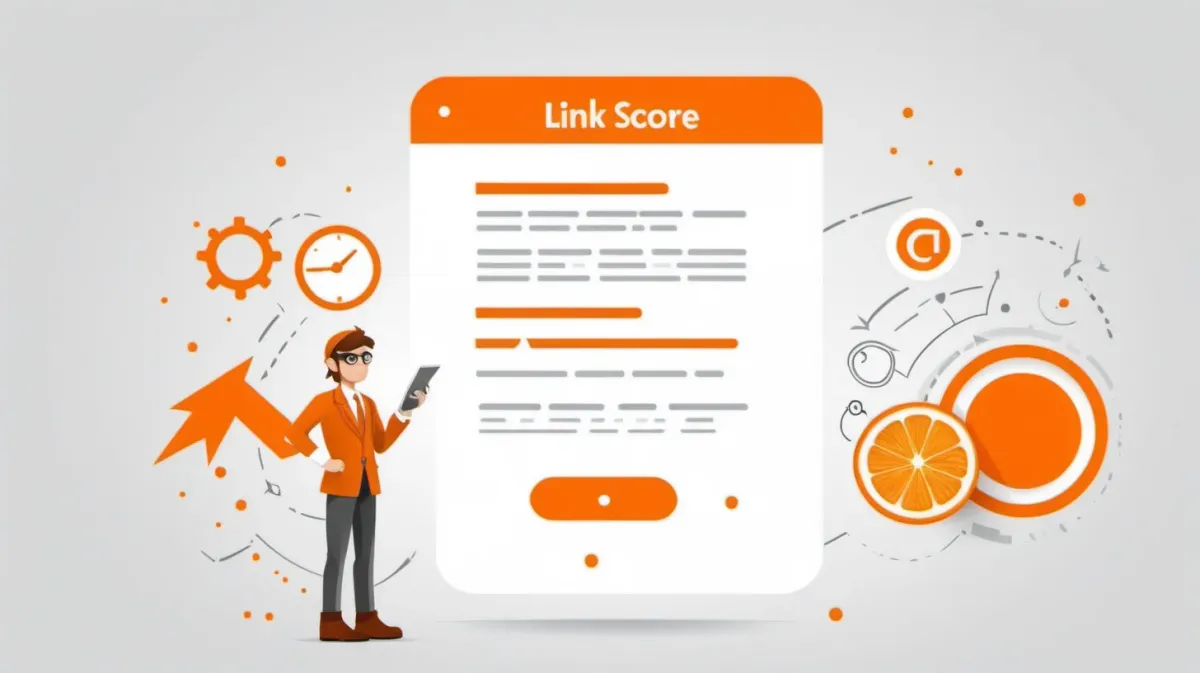A Structured Guide to Link Score and SEO Optimization

In search engine results, websites that have a lot of links do 30% better. A structured lesson will help you learn about link score and how it affects SEO strategies.
What are we going to talk about?
- Link Score: A Way to Measure Quality and Trustworthiness
- How to Figure Out the Link Score: What Makes an Excellent Consequence
- What This Means for SEO: How the link score affects rankings
Learn about the different parts of a link score and how they affect the online world. Find out how important link scores are in the constantly changing world of SEO.
Understanding Link Score
Link score is a metric used to evaluate the value and authority passed through backlinks from other websites. It provides a quantitative way to assess the quality and impact of inbound links pointing to a target webpage or website.
The link score is calculated by looking at various attributes of backlinks, including:
The number of backlinks - More backlinks generally mean a higher link score. However, link counts alone are not enough.
The quality of linking domains - Links from authoritative, reputable, and relevant sites count more than links from unimportant, spammy, or irrelevant sites.
Anchor text diversity - Links with varying anchor text help indicate the page is relevant for different keyword themes. Too much anchor text repetition looks unnatural.
Link velocity - Natural, steady link building over time is preferable to an unnaturally rapid influx of backlinks.
Link location on page - Links higher up on a page pass more equity than buried footer links.
Local vs global links - Local link building is important for geo-targeted SERPs. Global links influence worldwide rankings.
Follow vs nofollow links - Follow links pass equity, while nofollow links do not. However, nofollow links still provide brand exposure.
The link score of a page or site has a direct influence on search engine rankings and visibility. A higher link score helps pages rank better in SERPs, since search engines interpret backlinks as 'votes' of confidence that the content is useful and authoritative. Therefore, managing and improving link score is crucial for effective SEO and maintaining a competitive digital presence.
Preparing for Link Score Implementation

Audit Existing Backlinks
Check your backlink background before you rate links. The links on your site might be better after reading this.
Some tools look at backlinks:
- Ahrefs carefully looks at backlinks. There are harmful, spammy, and deceptive links.
- Majestic, like ahrefs, lets you look at your link profile with backlink statistics. Backlink changes can be seen in historical records.
- Even with these problems, Google Search Console gives you useful information about backlinks. The links report lists the most important sites and fake links.
- When Screaming Frog looks at connection data, it looks for problems. Look at harmful links, bad sites, and other things.
Try to find these backlinks:
- Toxic links - These are links from low-quality sites, link networks, or pages with thin or duplicate content. They can harm your site.
- Unnatural links - Links that violate Google's guidelines, such as paid links without nofollow, manipulated anchor text links, etc.
- Low-quality directories - Links from large directories or article sites provide little SEO value. Focus on higher quality placements.
- Irrelevant linking domains - Sites linking to you that have nothing to do with your industry or content. Be wary of these.
This backlink audit provides the foundation for your link building strategy.
Evaluate Link Quality
Backlink quality is crucial to understanding how they effect your site's link score. Assess link quality using many factors:
Linking Domain Metrics
- Domain Authority (DA) and Page Authority (PA) from Moz determine a site or page's SEO value based on backlink counts and quality. High DA/PA links are usually worth more.
- Moz spam scores highlight a site's questionable internet practices. Linking to spam hurts rankings.
- Majestic's Trust and Citation Flows show a site's authority. Higher values indicate better domains.
Quality Content
- Does the page have specialty content? Low-quality, stolen, or irrelevant content?
- Natural, contextual anchor text or over optimized? Optimised anchor text hurts.
- Is the page navigable? Does it have bothersome ads, popups, etc.? Poor UX reduces link value.
Identify Toxic Links
Watch out for links from:
- Link networks or farms
- Sites hit with manual/algorithmic penalties
- Pages with scraped or thin content
- Comment spam links
These toxic links should be disavowed to protect your site's reputation and link score. Disavow helps you tell Google's algorithm to overlook problematic connections. To disavow the link:
- First, identify each specific toxic link you want to disavow. Don't disavow whole domains unless every link from that domain is bad.
- Go to the Google Search Console and select Disavow Links under Manual Actions.
- Upload a CSV or TXT file with one toxic link per line.
- Submit your disavow file and Google will process it within a few days.
Disavowing harmful links won't fix algorithmic penalties. Stay away from dangerous links. Without control over unwanted links, disavow can protect your site.
Understand Link Distribution
A balanced, diversified link profile is an essential component of an effective SEO strategy. The distribution of links can impact how Google and other search engines evaluate a site's authenticity and authority.
There are several key factors to consider when examining link distribution:
- Ideal Link Profile Structure
- Balance of Anchor Text
- Placement in Content
Step-by-Step Implementation

Step 1: Developing a Scoring System
When developing a scoring system for link analysis, there are a few key factors to consider:
Metrics to Include:
- Domain Authority
- URL Rating
- Link Type
- Link Location
- Linking Root Domains
- Anchor Text
Weighting Different Factors
Assign weights to each factor based on its relative importance. For example:
- Domain Authority - 30%
- URL Rating - 20%
- Link Type - 15%
- Link Location - 10%
- Linking Root Domains - 15%
- Anchor Text - 10%
Tweak the weighting over time as you analyze results.
Benchmarking Scores
Set benchmark scores to categorize links as high, medium or low quality. For example:
- High - 75+
- Medium - 50-74
- Low - 0-49
Adjust benchmarks upwards as you build your linking profile. Set goals like acquiring 10+ new high quality links per month.
Step 2: Identifying High-value Link Opportunities
Finding high-value link opportunities that can positively influence your link score takes research and outreach. Here are some tips:
Researching relevant websites: Make a list of websites in your industry that would be suitable linking partners.
Finding sites accepting guest posts: Many blogs accept contributed guest posts in exchange for a backlink.
Outreach process and tactics: Personalize your outreach by referring to specific posts on the site you liked.
Step 3: Building and Acquiring Quality Links
Building and acquiring high-quality links is one of the most challenging but rewarding aspects of optimizing link score. Here are some of the most effective tactics to get valuable links pointing to your site:
- Create content assets like tools, research reports, guides, and data studies that naturally attract links without having to ask.
- Identify relevant websites and influencers to pitch guest posts, contributed articles, joint studies, and other content collaborations.
- Promote existing link worthy content through social media, paid ads, outreach emails, infographics, and media publicity.
Step 4: Integrating Link Score into SEO Strategy
When developing an SEO strategy, make link building a priority work stream. Define the purpose of your link building - is it to improve domain authority, boost rankings for target keywords, or increase referral traffic? Understanding the "why" will inform the types of links you aim to acquire.
Set specific goals around improving your link score by certain percentages over set timeframes. For example, aim to increase your site's link score by 20% quarter-over-quarter.
Monitoring and Adjusting Your Link Score Plan
Keeping tabs on your link score is like checking your website's pulse. Regularly monitor key metrics like domain authority, backlink profile health, and anchor text distribution. Tools like Moz, Ahrefs, and SEMrush offer comprehensive dashboards to track these vital signs.
Tracking Link Score Performance
Remember, a high link score isn't everything. Focus on the quality of your backlinks, not just the quantity. Look for backlinks from relevant, high-authority websites with engaged audiences. Consider metrics like domain rank, traffic volume, and social media presence to assess the value of each backlink.
Tweaking the Scoring System
No single link score system is perfect. Adapt your scoring model to reflect your specific goals and industry. Assign higher weights to backlinks from relevant niche websites or those with strong engagement metrics.
"The key to link score optimization is to balance quantity and quality," emphasizes Sarah Jones, a seasoned SEO specialist. "Focus on building genuine relationships with other websites in your niche, and the high-quality backlinks will naturally follow."
Advanced Techniques and Considerations

Once you've mastered the basics, it's time to explore advanced tactics.
Leveraging Automation in Link Scoring
Technology is your friend! Tools like Linkbot can automate much of the interlink analysis process, saving you time and effort. These tools can identify spammy backlinks, broken links, and potential penalties, allowing you to take corrective action quickly.
Ethical Considerations and Best Practices
Remember, SEO is a marathon, not a sprint. Avoid black-hat tactics like link buying or keyword stuffing. Focus on building a sustainable backlink profile through high-quality content creation, guest blogging, and social media outreach.
"Building trust and authority is the cornerstone of sustainable SEO," advises John Smith, CEO of a leading digital marketing agency. "Focus on creating valuable content that resonates with your audience, and the organic backlinks will come naturally."
Optimize Your Link Score Strategy Today!
In SEO, it's very important to understand and use a link score plan. We've looked at all the different parts of link score optimization, from figuring out how to use this dynamic sign in your SEO plan to judging the quality of links.
This path shows how important systems like Linkbot are and how it automatic help makes internal linking easier and improves link scores.
Search engine rankings and site SEO are both improved by adding useful internal links on the fly. As you work to improve your link score today, you might want to use one to help your SEO.
FAQs About Link Score
What is Link Score in SEO?
Link Score in SEO is a metric that evaluates the quality and relevance of backlinks pointing to a website. It helps assess the authority and trustworthiness of external links.
Why is Link Score Important for SEO?
Link Score is crucial for SEO because search engines like Google consider high-quality backlinks as a ranking factor. A good Link Score indicates a strong link profile, which can improve a website's search engine rankings.
How is Link Score Calculated?
Link Score is calculated based on various factors such as domain authority, relevance, link type (Do-follow or No-follow), and the number of links. Each factor is assigned a weight, and the scores are combined to determine the overall Link Score.
What Are High-Quality Backlinks?
High-quality backlinks come from authoritative and relevant websites in your niche. They are usually Do-follow links and carry more weight in improving your Link Score and SEO.
How Can I Improve My Link Score?
You can improve your Link Score by acquiring high-quality backlinks from reputable sources, removing toxic or spammy links, and regularly monitoring and optimizing your link profile.
